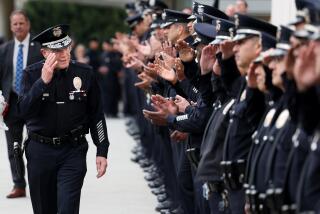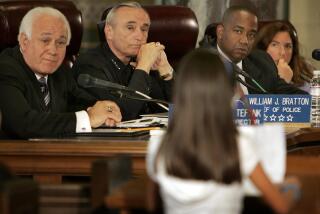Critic’s Notebook: What’s new is old at the Planning Department
It’s back to the status quo at the Planning Department. And that’s unfortunate news for anybody concerned about the shape of public space in Los Angeles, the city’s fading reputation as a home for cutting-edge architecture or the balance of Mayor Antonio Villaraigosa’s time in office.
When Gail Goldberg announced in late June that she was leaving her post as planning director after nearly five years, the city’s pundit class shifted into high gear, ruminating on whether she was pushed out, which she appears to have been, organizing panel discussions — one of which I took part in on Wednesday evening — and putting together open letters to the mayor about the kind of candidate who might excel in the job. As it turned out, they were a step slow: The mayor tapped Michael LoGrande, 39, a veteran of the department and most recently its top zoning administrator, to take Goldberg’s place before the chair in her City Hall office had a chance to cool. LoGrande was confirmed Wednesday by the City Council.
That left events like Wednesday’s panel at Southwestern University Law School — a hydra-headed affair featuring nearly a dozen panelists and moderated by planner and former councilmember Michael Woo — with an after-the-fact feel. LoGrande himself gamely showed up, offered some understandably cautious if rather dour opening remarks and then took a seat in the front row, which did little to promote a conversation full of candor or unvarnished opinion.
LoGrande deserves a chance to prove himself and make his own mark on the department, to be sure. But the way the mayor handled his appointment is hardly encouraging — not for the unfinished goals Goldberg left behind, which were concerned mostly with streamlining the department’s structure and completing a number of neighborhood-specific community plans, and certainly not for the notion that the planning director is the one department head with the potential to articulate a broad vision for the future of the L.A. cityscape.
Most damning of all, the speed with which Villaraigosa made the choice suggests that he sees the planning department less as he did when he was first elected — as a platform from which to launch a new vision of how this city is planned and designed — and more the way his mayoral predecessors, and earlier planning directors, have seen it. Which is to say primarily as a place where the top priority is keeping big real-estate projects moving through the approvals process as smoothly as possible.
Before Villaraigosa appointed Goldberg in early 2006, he launched an ambitious and wide-ranging search. He convinced Goldberg to leave her post as planning director in San Diego, where she had effectively staked out a wide patch of political middle ground where some forward-looking planning ideas could be embraced by real-estate developers. Goldberg is no radical or visionary, but her appointment in Los Angeles strongly suggested that the mayor hoped to work with the planning department to take an active role in reshaping the city as it grows denser and moves haltingly toward a comprehensive transit system.
This time there was no search. Bypassing Goldberg’s preferred successor, deputy planning director Vince Bertoni, the mayor reached down the ladder in the department to elevate LoGrande. He did so swiftly enough to suggest that even before Goldberg had any idea she’d be leaving LoGrande may have been the preferred choice among the mayor’s inner circle, which is these days dominated by First Deputy Mayor Austin Beutner.
Two pairs of comments on LoGrande have been most telling. The first came from planner Mark Winogrond, who aided Villaraigosa in the process that led to Goldberg’s hiring. In a blistering piece for the Planning Report, Winogrond blasted LoGrande’s selection.
“Michael LoGrande has just become the parent of the only L.A. agency devoted to a better physical future,” he wrote. “Nothing in his past has demonstrated that he is able to create teams who are willing to follow him into the tunnels of Hell in order come out the other side having shaped a better Los Angeles …
“We can only pray that he surprises us and shocks us, with his independence, his leadership, his patient understanding of the complexities of making a better city in the midst of false crises and urgency.”
Another batch of meaningful commentary came from Beutner himself. “I look at Michael as someone who gets things done,” he told my colleague David Zahniser. “That doesn’t mean that he’s going to roll over for developers. It just means Michael will get to a yes or a no, and I think that’s a good thing.”
The implication seemed clear enough: that the main problem with the planning department under Goldberg was that it was not friendly or efficient enough for developers. Certainly, the planning process in L.A. in awash in red tape. But I would put that issue far down the list of the department’s chief shortcomings.
For me, getting “to a yes or a no” ranks as a priority well below figuring out a way to chip away at the retrograde urban-design influence wielded by the Department of Transportation, which seemingly never met a road-widening project it didn’t like, and other city agencies. Or prying some planning power away from the members of the City Council and their planning deputies, who frequently engage in the kind of horse-trading — I’ll back a project in your district if you back one in mine — that leaves the Planning Department on the outside of the real planning process looking in.
As the recession drags on, the Planning Department will be less busy with new projects; speeding the approvals process will become less pressing as a concern. Ideally, a dormant economy is the time for a more open-ended and creative kind of planning.
With fewer new buildings in the pipeline, the key questions facing LoGrande are markedly less procedural or practical than they were during the boom years. They include: What are we to do with the vacant, half-built and abandoned properties that now dot the landscape of the city? How can bikes and pedestrians be made to feel more welcome on the city’s streets? How might the planning director work with the mayor and other city agencies to organize a series of design competitions for small-scale public projects that might steer work toward emerging local firms and make L.A. a center once again for innovative architecture? How can new transit stops be better connected to the neighborhoods around them?
Given these new recession-imposed realities, the ability to get things done may be less valuable for a planning director than the ability to imagine — as the city continues to struggle with debates over growth and density and the dominance of the car — how things might be different.
christopher.hawthorne@latimes.com
More to Read
Sign up for Essential California
The most important California stories and recommendations in your inbox every morning.
You may occasionally receive promotional content from the Los Angeles Times.










